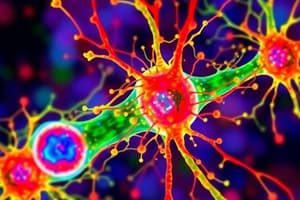Podcast
Questions and Answers
What role do microtubules play in the structure of cilia?
What role do microtubules play in the structure of cilia?
- They are composed of alpha and beta tubulin. (correct)
- They provide rigidity to cilia.
- They form the central lumen of cilia.
- They are involved in locomotion of cilia.
What structural arrangement is characteristic of flagella?
What structural arrangement is characteristic of flagella?
- 9 triplets of microtubules plus 2 central microtubules.
- A single row of microtubules.
- 9 doublets of microtubules plus 2 central microtubules. (correct)
- 4 bundles of microfilaments.
What is the primary function of motile cilia in the trachea?
What is the primary function of motile cilia in the trachea?
- Acting as a mucociliary escalator. (correct)
- Supporting lung elasticity.
- Regulating blood flow through the airways.
- Facilitating absorption of nutrients.
Which of the following statements about primary cilia is true?
Which of the following statements about primary cilia is true?
Which disease is associated with defects in the dynein arm of microtubules?
Which disease is associated with defects in the dynein arm of microtubules?
What is the potential consequence of having non-motile cilia in the fallopian tube?
What is the potential consequence of having non-motile cilia in the fallopian tube?
Which of the following is NOT a function of the cytoskeleton?
Which of the following is NOT a function of the cytoskeleton?
What type of microtubule arrangement do centrioles have?
What type of microtubule arrangement do centrioles have?
What condition can arise from a defect in primary cilia in renal tubules?
What condition can arise from a defect in primary cilia in renal tubules?
Flashcards are hidden until you start studying
Study Notes
Microtubules Overview
- Microtubules consist of alpha tubulin and beta tubulin proteins, crucial for cellular structure.
- The cytoskeleton serves as the cellular skeleton, composed of structural proteins that determine cell shape and provide support.
- Three main components of the cytoskeleton: microfilaments (actin), microtubules (tubulin), and intermediate filaments.
Microtubule Structure
- Microtubules are hollow cylinders made up of alpha and beta tubulin.
- They exist as polymers, where multiple subunits (monomers) form long chains (polymers) influencing cellular shape.
- The arrangement of microtubules can be either in triplets (found in centrioles) or doublets (found in cilia and flagella).
Cilia and Flagella
- Cilia (plural of cilium) resemble eyelashes and are present in eukaryotic cells.
- Structures of cilia and flagella: 9 doublets of microtubules plus 2 additional central microtubules (9+2 arrangement).
- Types of cilia:
- Motile cilia—found in the respiratory tract to move mucus.
- Non-motile primary cilia—sensory functions.
Functional Implications
- Dysfunction of motile cilia in the fallopian tubes can lead to ectopic pregnancy.
- Primary cilia are crucial for sensory detection in organs like the retina and olfactory system.
- Issues with primary cilia can result in diseases such as polycystic kidney disease and Cartagener's syndrome (affecting dynein arms).
Clinical Relevance
- Mutations in the CFTR gene lead to cystic fibrosis, causing thick mucus due to defective epithelial sodium channels.
- Understanding microtubule functions aids in recognizing the role they play in critical processes, such as cell division and organ development.
Centrosomes and Cell Division
- Centrioles, composed of microtubules, play a key role in organizing the mitotic spindle during cell division.
- Centrosomes consist of a pair of centrioles and are essential for proper chromosome separation.
Summary of Key Terms
- Cytoskeleton: Network of protein fibers providing support and shape to cells.
- Microtubules: Structural components that influence cell shape and movement.
- Cilia: Hair-like organelles aiding in movement and sensory functions.
- Flagella: Whip-like structures enabling locomotion in cells like sperm.
Studying That Suits You
Use AI to generate personalized quizzes and flashcards to suit your learning preferences.




